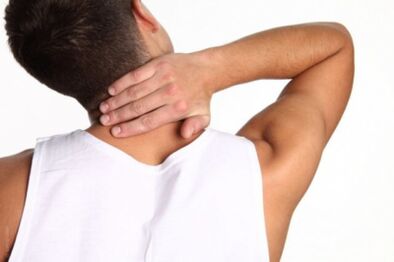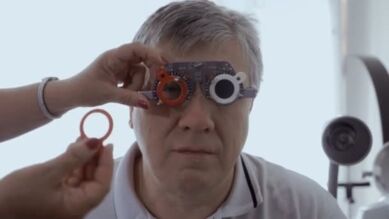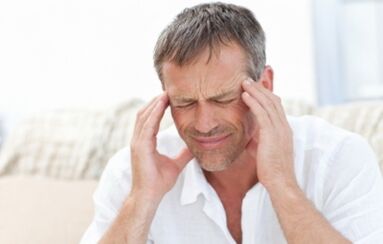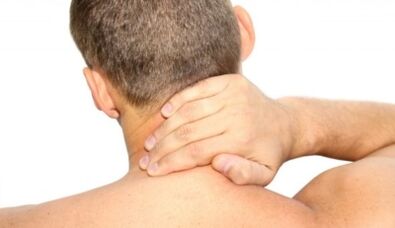In women, osteochondrosis of the cervix (COX) is diagnosed more often than in men. Despite this, their symptoms are almost identical. But it is worth remembering that the course of the disease in each patient occurs individually, regardless of gender.
Men react less attentively to any neck crisis, SHX symptoms are latent. This is due to the anatomy of people of different genders. The male muscles are developed, thus creating additional protection for the discs. They create a kind of shell that supports the vertebrae, which prevents their deformation.
The female spine adapts better to different stresses (related to childbirth and childbirth), but the symptoms of MCD appear more often and brighter.
How are men's spines and health related?

With the loss of SHX, the brain receives less nutrients, blockage of blood vessels occurs. Most often, men complain of migraines and dizziness.Men start to worry:
- Hypertension.
- The rhythm of coordination is disturbed, instability appears during walking.
- Reduced visual activity and sharpness.
- Hearing deteriorates, often tinnitus.
- The voice becomes hoarse and harsh, as if after an illness.
- Increasingly, women are starting to complain about their husbands snoring.
Symptoms
Various pains
Unpleasant sensations begin with strong movements of the cervical region. They may be accompanied by frequent forced expiration and sneezing. If the affected area is stretched by a strong wind or while diving into an ice hole, then the unpleasant sensations become acute. It is difficult for a man to turn his head, even a slight tilt provokes embarrassment.
If at the same time the middle toe or toe numbs or jumps, then more often WOH occurs in parallel with the disease of the spinal nerve roots.
Weakness of the upper limbs
Older men often complain of weakness and numbness of the bone tissue. Most often it manifests itself in the arms or legs, especially at night or during a sudden change of weather.
If nothing is done, muscle weakness will lead to numbness and atrophy. This occurs due to diseases in the spinal cord. The latter are directly related to the development of diseases of the spinal nerve roots.
Desensitization
Tissue sensitivity decreases as a result of blockage or inflammation of blood vessels. Sensuality is disturbed, which is manifested by ossification, chills, the skin in the affected area fades, during the massage takes on a bright red hue. Problems with blood vessels are often accompanied by a deterioration in blood flow.
Neck cracking and limited mobility

Crooked movements in the cervical region do not always signal dangerous diseases, which indicate pathological processes. It can be caused by genetic predisposition. Most often it occurs as a result of increased load in the cervical region. Another reason is spasm or maximal relaxation of muscles that do not have time to respond to contractions.
Crunchy movements appear in response to excessive joint mobility. They can be provoked by frequent and intense physical exercises to strengthen the back muscles.
Often, crunchy movements in the cervical region appear with rapid turns of the head, which signals the development of such pathologies:
- Dystrophic disorders in articular cartilage.
- Prickly growth of bone tissue along the edges of the bodies.
- Salt deposits.
- Displacement of a bone in a joint due to trauma.
- Displacement of the pulposus nucleus of the intervertebral disc with rupture of the annulus fibrosus.
- Spondylolisthesis.
- Cartilage deformation.
The spine loses its shock-absorbing properties, the friction intensity and its force are doubled and a crack appears. Because of this, the spine lowers physiologically, which causes a restriction of motor activity during tendencies or movements of the pelvis in a circle.
Loss of coordination and dizziness
The problem develops with the lack of blood supply, which feeds the complex receptor of the vestibular analyzer.
The patient suddenly has forced expulsion or incitement to vomit. A person feels tight during movements, the legs give way, the person is disoriented in space.
Blurred vision and hearing, numbness of the tongue

A man has a veil over his eyes, white dots resembling small flies. Over time, the picture becomes clear, then becomes blurry, such flashes can occur after a few minutes and continue continuously. They can stop themselves after a while. Sometimes a man begins to disorient in time and space.
Hearing loss is also diagnosed.The man more and more begins to ring in his ears, he hears noises. Often the sound appears in one ear, less often in both at the same time. Sometimes men are bothered by the feeling of a plug in their ears, which itches from time to time.
Sore throat
Experts call this symptom cervical osteochondrosis of the pharynx. A man seems to have a mucous plug in his throat, finds it difficult to speak, to breathe, he begins to cough allergic. The cap provokes sweating, which is indicated by sore throat. The mucous membrane, due to frequent dry unproductive cough, dries, there is a burning sensation, itching. After that, a classic sore throat starts, the voice becomes hoarse. If you do not determine the root cause of such a reaction, over the years the situation will only get worse.
Feeling in the heart, feeling of pressure in the chest
In some caseswith SOH, tingling sensation occurs in the shoulder or elbow joint area. In this case, compressive movements in the chest region are diagnosed. The heart muscle or liver often feels like a tingling sensation because the blood circulation is disturbed and the organs do not receive the necessary amount of nutrients that the blood distributes.
Over time, due to SHOH, the heart begins to pierce and tighten tightly, the heartbeat accelerates.
Redness of the skin
Due to SOC, neurological problems start in the area of the brain, which regulates its neuroendocrine activity and homeostasis of the body. This provokes chronic fatigue syndrome, a man wants to sleep all the time, his mood often changes, his skin becomes bright red.
Except this,neurology becomes the cause of depression, a man is haunted by panic attacksand unreasonable fear. The skin becomes bright red, then fades sharply, the pressure increases, the heart beats faster.
In this case, sexual activity decreases in men, urination becomes difficult and apathy for food appears.
Other signs

- Sudden vasospasm. A person accidentally loses orientation in space and "falls off his feet". In this case, it should be placed on a firm surface and waited for a while until the blood supply to the brain is improved. The man will come to his senses after a few minutes, but after that he will feel tired, his head will start to ache.
- The pain can affect the arms, shoulders and also the cervical region. It often appears in the occipital lobe, squeezing a man's head like an edge.
- Increased tone of the upper chest. At night the muscle corset is in good shape, which affects tension.
- Pressed nerve roots. Symptoms may vary. It depends on the course of the disease, its stage and the spine itself affected. For example, the fingers may become numb or all limbs may become paralyzed.
- Neuralgia of the nerve roots in the back of the head. This symptomatology is typical for representatives of the stronger sex, in whom inflammatory processes occur or the nerves of the cervix become irritated during the disease. As a rule, this occurs during frostbite or increased pain of the occipital region.
The attack occurs in men suddenly, resembling an electric shock. Such a negative reaction lasts only a few minutes, then the pain begins to subside. Neuralgia manifests itself up to 5 times a day. At the same time, the occipital lobe loses sensitivity, lumps appear.
Diagnostic methods
The patient should undergo an examination course to determine the affected areas before starting therapy.
Diagnostic technique:
- MRI or CT.
- X-Ray.
- Rheumatic tests.
Which doctor should I contact?

If a man experiences a range of symptoms that provoke SOH, it is best to contact a specialist immediately. Who to contact:
- Therapist. They perform an initial examination, give advice. If SOS symptoms are detected, the patient is referred to a specialist in a narrow field of work.
- Neurologist / Neurologist. WOH is a type of neurological disease, so a man should be consulted by a neurologist (neuropathologist).
- Specialist in vertebroneurology. This specialist chooses the method of therapy and diagnoses the condition of the spine.
- physiotherapists. It eliminates diseases using non-traditional methods of treatment, among which acupuncture stands out. This improves blood circulation and relieves muscle spasm.
When is it necessary to contact a specialist?
- With primary symptoms of changes in visual and auditory activity.
- Pain that can not be relieved by pharmacological agents.
- Vascular spasms that cause loss of consciousness.
Development and course of the disease
- First degree of SHOH: minor pathologies in the area of the pulposus nucleus of fibrocartilaginous formation. Excessive load provokes dehydration of the nucleus, which negatively affects the size of the disc and the formation of cracks.
- The second stage of SEE: the height of the discs decreases rapidly, the spine begins to decrease. This provokes increased vertebral motility.
- Third stage: prolapse and extensions of intervertebral discs are formed, may be associated with the development of chronic spasm of intervertebral joints.
Treatment

Treatment is complex therapy, depending on the stage of development of the disease, lasts from 30 to 90 days of intensive therapy and 12 months of support measures to consolidate the results, as well as prevent relapses.
Conservative therapy of the disease - taking pharmacological drugs, performing complex gymnastics.Surgical intervention will be justified only in the absence of positive dynamics,disease progression.
Folk remedies
The celery root is pressed and taken in dimensions: 4 gr. the root is poured with a liter of hot water. Inject for one day and filter. Take 10 grams three times a day.
In folk therapy, self-massage or the use of a needle applicator will be excellent.


















